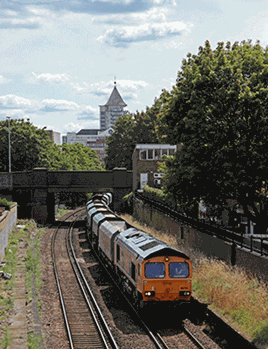The rail freight market is certainly a challenging sector at the moment. With the coal market declining and the UK steel industry in jeopardy, freight operators need to cast the net wider to find work.
At GB Railfreight, this has been happening for many years. The company celebrated its 15th anniversary on March 31, and in that time it has been able to grow through its ability to innovate.
It broke into the intermodal market, followed by coal, where it rapidly gained significant market share. In the past year the company has started operating passenger trains for Caledonian Sleeper, and it has picked up contracts in the London area for aggregates, resulting in the need to expand its operations and buy new kit.
Rather than rely on traditional traffic, GBRf has targeted new markets to find what could be achieved and is setting out to win this work.
Lee Armstrong is the company’s business manager for aggregates and rail services. The latter is the name given to the various stock moves required by rolling stock leasing companies (ROSCOs) and the train operating companies (TOCs), and is big business these days. It can also be tricky.
It may not sound like a big market, but it is… and it’s only set to get bigger, as Armstrong explains: “With investment from the Government there’s a lot of those unit moves to go after. The expectations on them are a little bit different as well, because it’s not your traditional rail market. For instance, today for a rail move due at 1300 the maintenance provider has told us ‘it’s going to come back tomorrow’.”
That was for a move from Doncaster to Scotland. And it created problems for GBRf because its staff were already on the move, and were only an hour away from the Yorkshire town when they were contacted and told to head back home.
How many of these jobs are ad hoc, with GBRf getting a phone call asking for something as soon as possible?
“We’ve got quite busy, so we’re not able to adapt that quickly, but it’s one of the things we’re trying to do,” Armstrong says.
Potentially there is a lot of work available - quotes of around £15 million worth of work are mentioned. GBRf has been working closely with all the major providers (ROSCOs, TOCs, maintenance providers and manufacturers) to find out what their needs are, and to understand any issues.
The latest edition of the Long Term Passenger Rolling Stock Strategy, released by the Association of Train Operating Companies in late March, suggests that an average of 17 new vehicles per week must be delivered between now and 2020 (RAIL 798). On top of that are the refurbishment deals that have to be placed - it all adds up to a lot of potential.
Armstrong adds: “It’s not the cost of the accounts of a train onto the network, it’s the cost of a whole workforce sat around for a week. Some of these areas (especially Southern where they’ll only move on a Saturday), if we don’t turn up it’s another week before that unit can move. That means there’s a whole team of 50 guys at Doncaster with no work to do, so Wabtec is picking up the bill. It’s huge money for them if we don’t deliver a train on time.”
This represents quite a departure for GBRf and its usual operating model. Usually one locomotive hauls one rake of wagons on a cycle until an exam is needed. The operator believes in ‘sweating its assets’ and working its staff hard - isn’t rail services a bit of a change to that? Doesn’t it put a bit of a strain on operations?
Armstrong nods: “It does a little bit, but the guys adapt to it pretty well. The drivers we put on this work, they’re drivers that enjoy it. They enjoy the flexibility - they’re not the kind of driver that likes to be on a set turn every day. They like that one day they’re going to Doncaster Wabtec, the next day they’re on a Sleeper, and the next on an intermodal train. And they’re quite adaptive - they don’t mind living in hotels.”
But while rail services is certainly one for the future, aggregates is for the here and now.
GBRf Managing Director John Smith has declared that the company is helping to build London - for example, it has contracts with Crossrail to operate construction trains and to move material to and from the city. It has also found strategic terminals and loading points around London to serve, and began a five-year deal last year with Aggregates Industries (AI) to serve quarries in Leicestershire and around London.
Clearly there is potential in this sector, too. Armstrong describes it as “huge”, adding: “We took a bit of a dent with SSI and again with Tarmac, because we wanted the Northern package, and that eroded about a third of what we already bid for. So we’re hoping to grow further into the market.”
Despite the apparent growth, recent Office of Rail and Road statistics showed that aggregates had dipped - of the seven principal freight commodities carried, it was one of five that had experienced recent decline. Was the collapse of SSI and the associated trains (limestone served the steelworks) behind that?
“It probably would be. We dropped three wagon sets and three locomotives on that,” says Armstrong.
However, every cloud has a silver lining - the sudden available capacity will enable GBRf to bid for other work. For example, the decline in coal allied to the rise in aggregates has led to GBRf converting coal wagons that are less than a decade old into aggregates hoppers.
Armstrong tells RAIL: “We’ve had one running around - we’ve been trialling it on an AI set in the North, close to where it’s been converted. We should see them out in July.”
















Login to comment
Comments
No comments have been made yet.